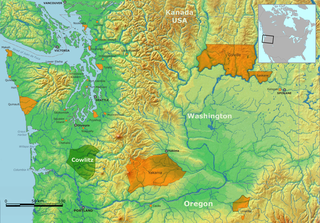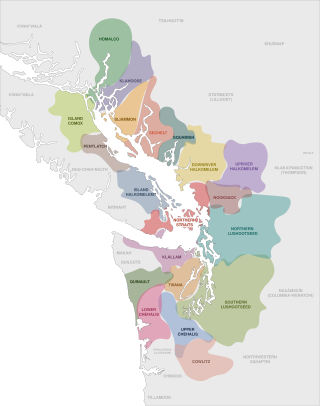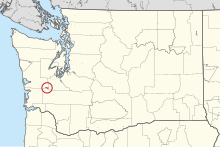
The Muckleshoot are a Lushootseed-speaking Native American tribe, part of the Coast Salish peoples of the Pacific Northwest. They are descendants of the Duwamish peoples whose traditional territory was located along the Green and White rivers, including up to the headwaters in the foothills of the Cascade Mountains, in present-day Washington State. Since the mid-19th century, their reservation is located in the area of Auburn, Washington, about 15 miles (24 km) northeast of Tacoma and 35 miles (56 km) southeast of Seattle.

The Chehalis people or Tsihalis are a Native people of western Washington state in the United States. They should not be confused with the similarly named Chehalis First Nation of the Sts'Ailes people along the Harrison River in the Fraser Valley area of British Columbia.

The term Cowlitz people covers two culturally and linguistically distinct indigenous peoples of the Pacific Northwest; the Lower Cowlitz or Cowlitz proper, and the Upper Cowlitz / Cowlitz Klickitat or Taitnapam. Lower Cowlitz refers to a southwestern Coast Salish people, which today are enrolled in the federally recognized tribes: Cowlitz Indian Tribe, Quinault Indian Nation, and Confederated Tribes of the Chehalis Reservation. The Upper Cowlitz or Taitnapam, is a Northwest Sahaptin speaking people, part of the Confederated Tribes and Bands of the Yakama Nation.
The Nisqually are a Lushootseed-speaking Native American tribe in western Washington state in the United States. They are a Southern Coast Salish people. They are federally recognized as the Nisqually Indian Tribe, formerly known as the Nisqually Indian Tribe of the Nisqually Reservation and the Confederated Tribes of the Chehalis Reservation.

The Tulalip Tribes of Washington, formerly known as the Tulalip Tribes of the Tulalip Reservation, is a federally recognized tribe of Duwamish, Snohomish, Snoqualmie, Skagit, Suiattle, Samish, and Stillaguamish people. They are South and Central Coast Salish peoples of indigenous peoples of the Pacific Northwest Coast. Their tribes are located in the mid-Puget Sound region of Washington.

The Coast Salish languages, also known as the Central Salish languages, are a branch of the Salishan language family. These languages are spoken by First Nations or Native American peoples inhabiting the Pacific Northwest, in the territory that is now known as the southwest coast of British Columbia around the Strait of Georgia and Washington State around Puget Sound. The term "Coast Salish" also refers to the cultures in British Columbia and Washington who speak one of these languages or dialects.

The Confederated Salish and Kootenai Tribes of the Flathead Reservation are a federally recognized tribe in the U.S. state of Montana. The government includes members of several Bitterroot Salish, Kootenai and Pend d'Oreilles tribes and is centered on the Flathead Indian Reservation.

The Pend d'Oreille or Pend d'Oreilles, also known as the Kalispel, are Indigenous peoples of the Northwest Plateau. Today many of them live in Montana and eastern Washington of the United States. The Kalispel peoples referred to their primary tribal range as Kaniksu.

The Kootenai Tribe of Idaho is a federally recognized tribe of Lower Kootenai people. They are an Indigenous people of the Northwest Plateau based in northern Idaho.
The Confederated Tribes of Siletz Indians in the United States is a federally recognized confederation of more than 27 Native American tribes and bands who once inhabited an extensive homeland of more than 20 million acres from northern California to southwest Washington and between the summit of the Cascades and the Pacific Ocean. After the Rogue River Wars, these tribes were removed to the Coast Indian Reservation, now known as the Siletz Reservation. The tribes spoke at least 11 distinct languages, including Tillamook, Shasta, Lower Chinook, Kalapuya, Takelma, Alsea-Yaquina, Siuslaw/Lower Umpqua, Coos, the Plateau Penutian languages Molala and Klickitat, and several related Oregon Athabaskan languages.
Cowlitz, also known as Cowlitz Salish, is a Tsamosan language of the Coast Salish family of Salishan languages. It was spoken by the Lower Cowlitz people of the Cowlitz Indian Tribe and is spoken today by both Lower and Upper Cowlitz people. Although it went dormant in the 1960s, it is being revitalized by the Cowlitz Tribe.

The Upper Skagit Indian Tribe is a federally recognized Native American tribe located in the state of Washington. Before European colonization, the tribe occupied lands along the Skagit River, from as far downstream as present-day Mount Vernon, Washington, and villages going north as far as Newhalem along the Skagit River, as well as lands on the Baker, and the Sauk rivers.

The Salish peoples are indigenous peoples of the American and Canadian Pacific Northwest, identified by their use of the Salish languages which diversified out of Proto-Salish between 3,000 and 6,000 years ago.
The Nisqually Indian Tribe of the Nisqually Reservation is a federally recognized tribe of Nisqually people. They are a Coast Salish people of Indigenous peoples of the Pacific Northwest. Their tribe is located in the State of Washington.
Upper Chehalis is a member of the Tsamosan (Olympic) branch of the Coast Salish family of Salishan languages. Thompson's 1979 classification lists Upper Chehalis as more closely related to the Cowlitz language than it is to Lower Chehalis.

The Quinault Indian Nation, formerly known as the Quinault Tribe of the Quinault Reservation, is a federally recognized tribe of Quinault, Queets, Quileute, Hoh, Chehalis, Chinook, and Cowlitz peoples. They are a Southwestern Coast Salish people of indigenous peoples of the Pacific Northwest Coast. Their tribe is located in Washington state on the Pacific coast of the Olympic Peninsula. These peoples are also represented in other tribes in Washington and Oregon.

The Skokomish Indian Tribe, formerly known as the Skokomish Indian Tribe of the Skokomish Reservation, and in its own official use the Skokomish Tribal Nation, is a federally recognized tribe of Skokomish, Twana, Klallam, and Chimakum people. They are a tribe of Southern Coast Salish indigenous people of the Pacific Northwest located in Washington. The Skokomish are one of nine bands of Twana people.

The Kalispel Indian Community of the Kalispel Reservation is a federally recognized tribe of LowerKalispel people, located in Washington. They are an Indigenous people of the Northwest Plateau.

The Port Gamble S'Klallam Tribe, formerly known as the Port Gamble Indian Community of the Port Gamble Reservation or the Port Gamble Band of S'Klallam Indians is a federally recognized tribe of S'Klallam people, located on the Kitsap Peninsula in Washington. They are an Indigenous peoples of the Northwest Coast.

The Cowlitz Indian Tribe is a federally recognized tribe of Cowlitz people. They are a tribe of Southwestern Coast Salish and Sahaptan indigenous people of the Pacific Northwest located in Washington.

















